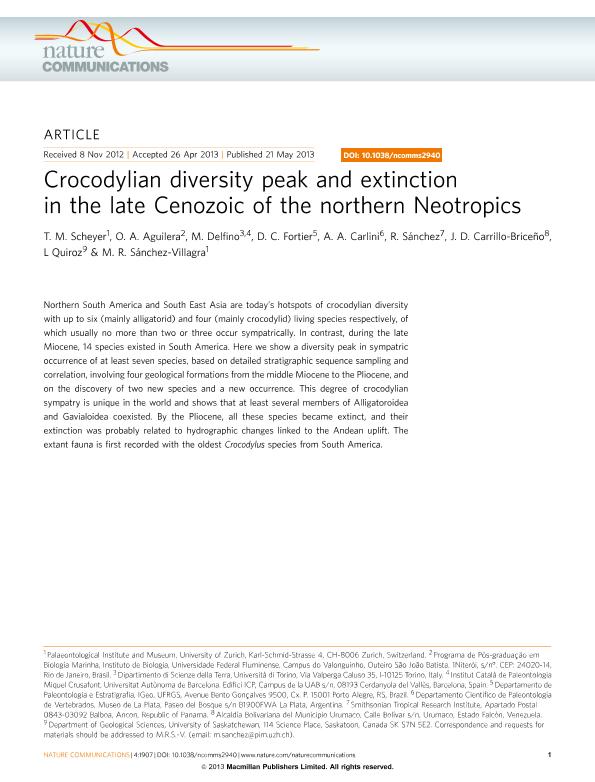Mostrar el registro sencillo del ítem
dc.contributor.author
Scheyer, T. M.
dc.contributor.author
Aguilera, Oscar Alberto

dc.contributor.author
Delfino, M.
dc.contributor.author
Fortier, D. C.
dc.contributor.author
Carlini, Alfredo Armando

dc.contributor.author
Sanchez, R.
dc.contributor.author
Carrillo Briceño, J. D.
dc.contributor.author
Quiroz, L.
dc.contributor.author
Sánchez Villagra, M. R.
dc.date.available
2017-03-08T19:47:11Z
dc.date.issued
2013-05
dc.identifier.citation
Scheyer, T. M.; Aguilera, Oscar Alberto; Delfino, M.; Fortier, D. C.; Carlini, Alfredo Armando; et al.; Crocodylian diversity peak and extinction in the late Cenozoic of the northern Neotropics; Nature; Nature Communications; 4; 5-2013; 1-9; 1907
dc.identifier.uri
http://hdl.handle.net/11336/13639
dc.description.abstract
Northern South America and South East Asia are today’s hotspots of crocodylian diversity with up to six (mainly alligatorid) and four (mainly crocodylid) living species respectively, of which usually no more than two or three occur sympatrically. In contrast, during the late Miocene, 14 species existed in South America. Here we show a diversity peak in sympatric occurrence of at least seven species, based on detailed stratigraphic sequence sampling and correlation, involving four geological formations from the middle Miocene to the Pliocene, and on the discovery of two new species and a new occurrence. This degree of crocodylian sympatry is unique in the world and shows that at least several members of Alligatoroidea and Gavialoidea coexisted. By the Pliocene, all these species became extinct, and their extinction was probably related to hydrographic changes linked to the Andean uplift. The extant fauna is first recorded with the oldest Crocodylus species from South America.
dc.format
application/pdf
dc.language.iso
eng
dc.publisher
Nature

dc.rights
info:eu-repo/semantics/openAccess
dc.rights.uri
https://creativecommons.org/licenses/by-nc-sa/2.5/ar/
dc.subject
Crocodylia
dc.subject
Norther Southamerica
dc.subject
Diversity
dc.subject
Late Cenozoic
dc.subject.classification
Paleontología

dc.subject.classification
Ciencias de la Tierra y relacionadas con el Medio Ambiente

dc.subject.classification
CIENCIAS NATURALES Y EXACTAS

dc.title
Crocodylian diversity peak and extinction in the late Cenozoic of the northern Neotropics
dc.type
info:eu-repo/semantics/article
dc.type
info:ar-repo/semantics/artículo
dc.type
info:eu-repo/semantics/publishedVersion
dc.date.updated
2017-03-06T14:07:49Z
dc.identifier.eissn
2041-1723
dc.journal.volume
4
dc.journal.pagination
1-9; 1907
dc.journal.pais
Reino Unido

dc.journal.ciudad
Londres
dc.description.fil
Fil: Scheyer, T. M.. Universitat Zurich; Suiza
dc.description.fil
Fil: Aguilera, Oscar Alberto. Universidade Federal Fluminense; Brasil. Consejo Nacional de Investigaciones Científicas y Técnicas; Argentina
dc.description.fil
Fil: Delfino, M.. Universita di Torino; Italia. Universitat Autonoma de Barcelona; España
dc.description.fil
Fil: Fortier, D. C.. Universidade Federal do Rio Grande do Sul; Brasil
dc.description.fil
Fil: Carlini, Alfredo Armando. Universidad Nacional de la Plata. Facultad de Ciencias Naturales y Museo. División Paleontología Vertebrados; Argentina. Consejo Nacional de Investigaciones Científicas y Técnicas; Argentina
dc.description.fil
Fil: Sanchez, R.. Smithsonian Tropical Research Institute; Panamá
dc.description.fil
Fil: Carrillo Briceño, J. D.. Alcaldía Bolivariana del Municipio Urumaco; Venezuela
dc.description.fil
Fil: Quiroz, L.. University Of Saskatchewan; Canadá
dc.description.fil
Fil: Sánchez Villagra, M. R.. Universitat Zurich; Suiza
dc.journal.title
Nature Communications

dc.relation.alternativeid
info:eu-repo/semantics/altIdentifier/doi/http://dx.doi.org/10.1038/ncomms2940
dc.relation.alternativeid
info:eu-repo/semantics/altIdentifier/url/http://www.nature.com/articles/ncomms2940
Archivos asociados
